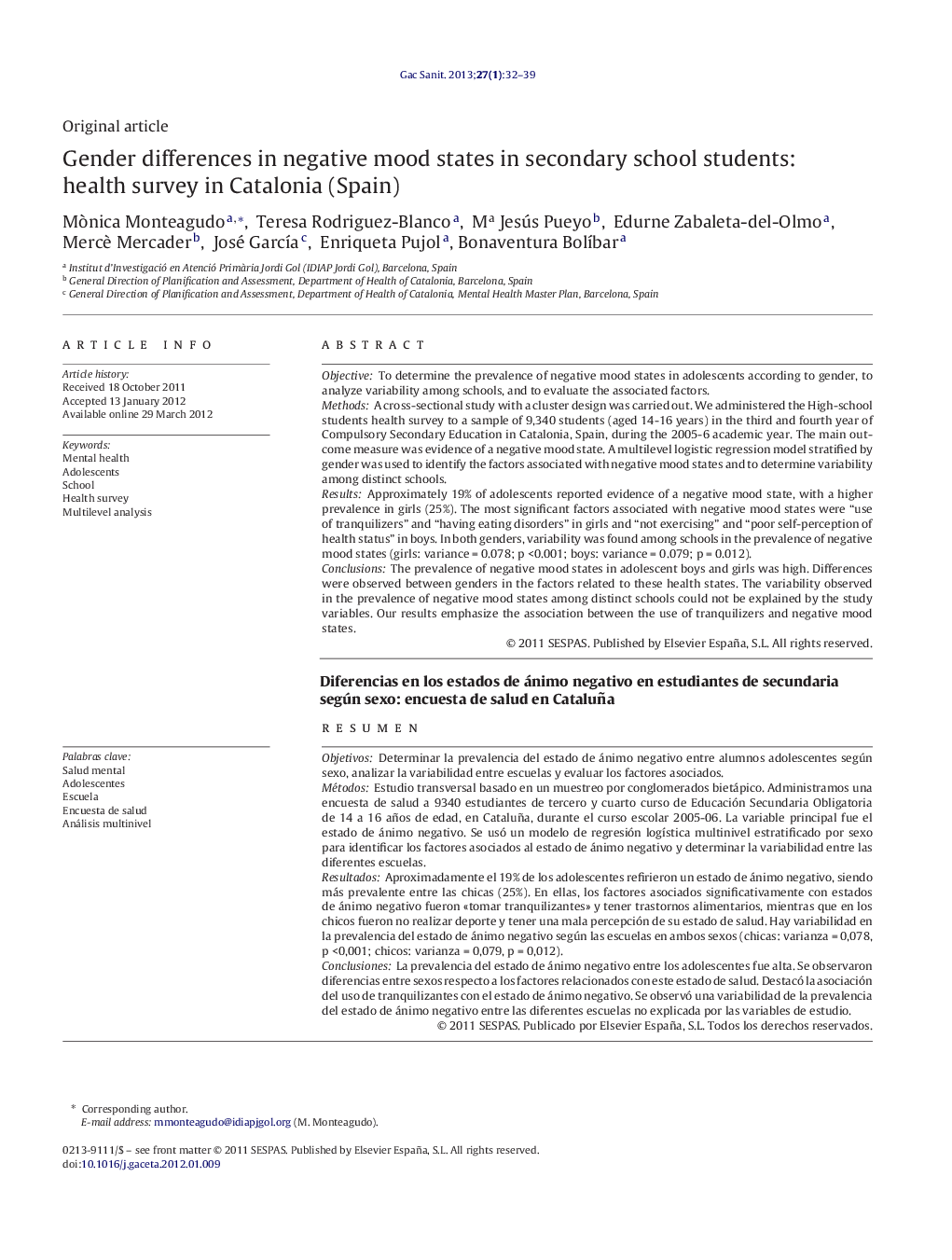| کد مقاله | کد نشریه | سال انتشار | مقاله انگلیسی | نسخه تمام متن |
|---|---|---|---|---|
| 1073530 | 949790 | 2013 | 8 صفحه PDF | دانلود رایگان |

ObjectiveTo determine the prevalence of negative mood states in adolescents according to gender, to analyze variability among schools, and to evaluate the associated factors.MethodsA cross-sectional study with a cluster design was carried out. We administered the High-school students health survey to a sample of 9,340 students (aged 14-16 years) in the third and fourth year of Compulsory Secondary Education in Catalonia, Spain, during the 2005-6 academic year. The main outcome measure was evidence of a negative mood state. A multilevel logistic regression model stratified by gender was used to identify the factors associated with negative mood states and to determine variability among distinct schools.ResultsApproximately 19% of adolescents reported evidence of a negative mood state, with a higher prevalence in girls (25%). The most significant factors associated with negative mood states were “use of tranquilizers” and “having eating disorders” in girls and “not exercising” and “poor self-perception of health status” in boys. In both genders, variability was found among schools in the prevalence of negative mood states (girls: variance = 0.078; p <0.001; boys: variance = 0.079; p = 0.012).ConclusionsThe prevalence of negative mood states in adolescent boys and girls was high. Differences were observed between genders in the factors related to these health states. The variability observed in the prevalence of negative mood states among distinct schools could not be explained by the study variables. Our results emphasize the association between the use of tranquilizers and negative mood states.
ResumenObjetivosDeterminar la prevalencia del estado de ánimo negativo entre alumnos adolescentes según sexo, analizar la variabilidad entre escuelas y evaluar los factores asociados.MétodosEstudio transversal basado en un muestreo por conglomerados bietápico. Administramos una encuesta de salud a 9340 estudiantes de tercero y cuarto curso de Educación Secundaria Obligatoria de 14 a 16 años de edad, en Cataluña, durante el curso escolar 2005-06. La variable principal fue el estado de ánimo negativo. Se usó un modelo de regresión logística multinivel estratificado por sexo para identificar los factores asociados al estado de ánimo negativo y determinar la variabilidad entre las diferentes escuelas.ResultadosAproximadamente el 19% de los adolescentes refirieron un estado de ánimo negativo, siendo más prevalente entre las chicas (25%). En ellas, los factores asociados significativamente con estados de ánimo negativo fueron «tomar tranquilizantes» y tener trastornos alimentarios, mientras que en los chicos fueron no realizar deporte y tener una mala percepción de su estado de salud. Hay variabilidad en la prevalencia del estado de ánimo negativo según las escuelas en ambos sexos (chicas: varianza = 0,078, p <0,001; chicos: varianza = 0,079, p = 0,012).ConclusionesLa prevalencia del estado de ánimo negativo entre los adolescentes fue alta. Se observaron diferencias entre sexos respecto a los factores relacionados con este estado de salud. Destacó la asociación del uso de tranquilizantes con el estado de ánimo negativo. Se observó una variabilidad de la prevalencia del estado de ánimo negativo entre las diferentes escuelas no explicada por las variables de estudio.
Journal: Gaceta Sanitaria - Volume 27, Issue 1, January–February 2013, Pages 32–39